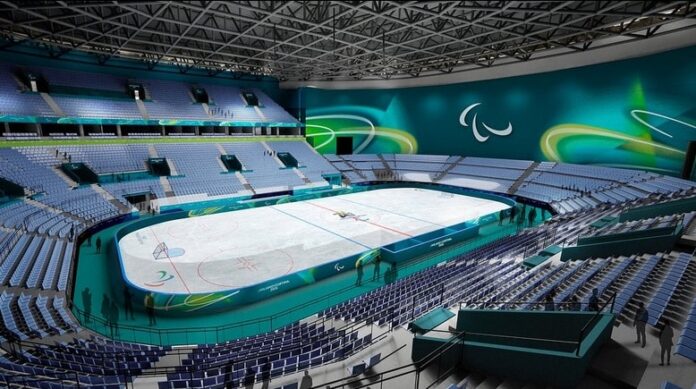While Nice will host several events of the 2030 Winter Olympics, including skating and the closing ceremony, the cost of the future ice site is drawing sharp criticism. Amid political decisions, financial concerns, and construction progress, the Nice project is dividing officials and observers.
Five years ahead of the “French Alps 2030” Winter Olympics, tension is rising around the Nice component of the project. The city is set to host figure skating, short track events, and the closing ceremony. However, the construction of a new ice rink estimated at 138 million euros and the setup of two temporary rinks within the Allianz Riviera, costing 80 million, has sparked debate, even within the ranks of the National Assembly.
On Monday, November 3, during the review of the Sport, Youth, and Community Life budget credits, deputy Frédéric Maillot (Democratic and Republican Left) challenged the Minister of Sports, Marina Ferrari. He stated, “It’s a budgetary madness, a rich man’s whim we cannot afford.” The sports budget rapporteur believes this decision stems from “a political choice rather than financial reasoning.”
Political and Local Discontent
The elected official from La Réunion relies on several arguments. He recalls that “the Pralognan-la-Vanoise ice rink (from the 1992 Games) is still operational” and that “there is an Olympic ice rink in Marseille.” Therefore, he questions the relevance of a new facility in Nice.
The overall cost is alarming: the new ice rink would be the only infrastructure fully built for the 2030 Winter Games, with other existing infrastructures set to be reused. But in Nice, criticisms extend beyond the parliamentary framework.
Juliette Chesnel-Leroux, opposition municipal councilor (EELV) and candidate for the 2026 municipal elections, denounces a decision disconnected from local realities. “Taxes have increased in Nice. We’re not going to ask the people of Nice to pay for a new facility for 15 days of events,” she states. She advocates for the use of the Marseille ice rink and more sustainable investments. “In Nice, let’s make sure people can engage in sports, not just watch the Olympics on TV.”
This stance partially aligns with observations from several administrative reports. A document from the general inspections of finance and education, sports, and youth, delivered in March 2025, proposes five alternative scenarios. The most economical, known as “plan E,” suggests setting up only one rink at the Allianz Riviera and relocating figure skating and short track to the LDLC Arena in Décines-Charpieu, Rhône. This scenario would allow for saving more than 180 million euros.
A Strong Ministerial Defense
In response to these criticisms, Minister of Sports Marina Ferrari defended the rationale behind the choice for Nice. According to her, the construction of the rink is part of a strategy of proximity and rationalization. “The choice of Nice is relevant,” she stated, highlighting the compactness of the Olympic setup in the Var plain, between the new ice rink, the athletes’ village, and the Allianz Riviera.
The minister also mentioned a local legacy: “there is a tradition of ice sports in Nice,” she noted, citing the example of the Aigles de Nice, who have played in Ligue Magnus for many years, and whose rink needs improvement. She emphasizes the adherence to the “budgetary framework” and the commitments made regarding austerity.
The debate unfolds within a broader context. The overall Games budget, adopted on October 20, amounts to 2.1 billion euros. Nearly 75% will come from private revenue, according to the Organizing Committee. However, political instability has delayed the vote on the specific law governing the organization of the Games and the approval of certain funding.
Despite the uncertainties, the Olympic Infrastructure Delivery Company (Solideo) continues its procedures. The organization has completed the first phase of selecting company groups for building the ice rink. The final winners are expected to be announced in the summer of 2026. Work would start at the end of 2027, with completion scheduled for the end of summer 2029.
In the Var plain, other projects are progressing. The future Olympic village, planned on a two-hectare site near the stadium, is to host about 1,500 athletes and companions. Three groups have been selected for the second consultation phase: Icade Promotion, Linkcity Sud-Est with Bouygues Immobilier, and Sogeprom in partnership with Demathieu Bard Immobilier.
The complex, covering 25,000 m², will include housing, shops, and services. In the post-Olympic phase, it will become a new residential neighborhood with 30% social housing, 20% in real solidarity lease, and a student residence. Delivery is also scheduled for summer 2029.
Damien Robert, executive director of Solideo Alpes 2030, specifies that “the proposals in terms of development, architecture, future uses, and sustainable legacy for the territory will be at the heart of upcoming workshops.”
An Uncertain Equation
Behind the political quarrel, a question persists: how to reconcile Olympic ambition with public spending control? For Frédéric Maillot, “the imperative of sound public fund management should not be flexible and should not fall behind political considerations.”
His amendment calling for a report on the cost of the ice rink and modifications to the Allianz Riviera was adopted in committee. It remains to be seen if it will be voted on in the public session on November 16.
At this stage, the government’s stance remains unchanged: Nice remains the ice hub for the 2030 Winter Games. The minister defends a “coherent” project, focused and inscribed in a logic of site reuse. But criticisms, echoed by opposition politicians and certain experts, cast doubt on the scale of future investments. In the Nice metropolis, the debate is not closed. Between the promise of international influence and the fear of an expensive legacy, the preparation for the “French Alps 2030” Games is entering a decisive phase.


